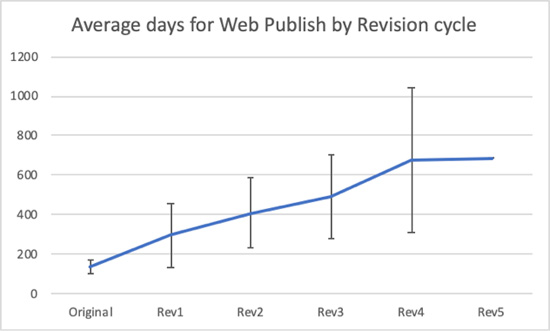Authors: Kristina Höök, Rob Comber
Posted: Fri, April 24, 2020 - 3:15:06
ACM Transactions on Computer–Human Interaction (ToCHI) is the premier ACM journal for HCI research. Founded in 1994, the journal has been publishing research at the cutting edge of HCI every second month since 2013. Since taking over the helm at ToCHI in November 2018, we have started to see a number of changes, from the number and types of papers submitted to the journal to trends and practices in our field—and now, amid a global pandemic, in the role and nature of research and academic publishing. We want to use this blog to tell you a little about ToCHI and to encourage you to consider it, and other journals, for publishing your research.
We realize that this comes at a time of difficulty for many people. Many of us now sit at home, trying to get teaching done over the Internet, rescheduling trips and events, and, most of all, worrying about those near and dear, our friends, our colleagues, our countries, and the financial situation. Publishing journal articles may be the least of our worries.
It may be hard to see any positive effects of the pandemic—aside from the drastic drops in air pollution, allowing mother earth to take a deep breath. Yet some of the challenges and opportunities we now face preceded the current crisis. Many have long argued that we need to stop traveling and instead conduct meetings and conferences over the Internet. Innovative solutions and full-scale tests of how to host conferences are suddenly being devised without much prior experience, pushing us into solutions and behaviors that we have been longing for. At the same time, for those of us spending our days videoconferencing, it has become clear how much more research on CSCW, UIST, and user practices is needed before this will become the better option. In short, it is clear that HCI work is badly needed!—as we start working more and more remotely in order to reduce carbon emissions; as we integrate digital interactions into every area of life in the Internet of Things era; as we shift toward whole-body interactions through novel interactive materials; and as we engage with AI and big data as a path to controlling and managing whole infrastructures efficiently. In our offices, we are trying to move everything online, from traditional lectures to co-design, from supervision meetings to after-work social events.
And we are learning. New practices are arising.
And so a window of opportunity for debating our own profession, including our publication strategies, opens. HCI is a conference-driven field, as is the whole field of computer science. This has had many positive effects on our young field: By meeting regularly, we have fostered a global understanding of what we expect in terms of quality, research methods, understanding of different cultures, and interdisciplinarity. But maybe we are now at a point in time where we can—and perhaps must—shift more of our work toward journal publications on the one end, and popular accounts of our insights in magazines, such as Interactions, on the other end?
While we can see many negative consequences of not meeting as often to share ideas, we might ask what, apart from reducing the environmental impact of our work, could be the benefits from such a shift? As editors of ToCHI, we see every day how journal articles give us an opportunity to provide more—more substance, a better grounding in the literature, a shift toward deeper reflection. This answers to a lack that HCI has struggled with for a long time. As many have argued before, our field needs to start building more coherence. The different subfields of HCI need to start building on one another’s work, developing research programs or even whole paradigms. We need to shift beyond importing theories and start forming our own. We need to probe the interaction design concepts and technologies we develop, testing their validity and reach, developing some coherence in our research methods and the knowledge we create.
How much substance are we talking about when we shift from conference to journal articles? In our experience, a good ToCHI paper often builds on work done over a longer time period. Instead of one short user study, there will be several studies, or a study done over a longer term. Instead of one exploration of a novel interaction technology, there will be several iterations. Instead of a limited literature review, there will be a substantial review providing an analytical framework that shifts a whole research topic forward. ToCHI publishes work that describes user studies done over months to properly observe behavior shifts or design work done over several years, building a whole new interaction model or a design program.
How do we know that there is substance in a submission? As ToCHI aims to be the flagship journal of the HCI field, we put high demands on the quality of papers we publish. The associate editors of ToCHI are leaders in our field with extensive knowledge of their respective subfields. We rely on their expertise to a larger degree than in, for example, the CHI conference review process. An associate editor of ToCHI will engage at least three reviewers, but will then, based on their input, make an independent decision on whether to accept, ask for revisions on, or reject an article.
It has often been argued that journals are too slow to cater to the needs of a rapidly changing field. Like many other journals, ToCHI has worked really hard on changing this. Our aim is to provide authors with a decision within eight to nine weeks from the time an article is submitted (average is currently 48.2 days). In most cases, revisions are needed, so how fast the next step progresses depends on the author. Papers require a median of two rounds of revision, though over 40 percent are completed with one or no revision cycle (see Table 1). Each revision cycle adds about four months to the process, while the average time from first submission to publication is 11 months. These days, as soon as the final, camera-ready version is submitted, it will immediately be published in the ACM Digital Library. With the exception of special issues, there is no longer any need to wait for the whole issue to be completed before individual articles become available. In effect, this means that the time from submission to seeing your paper in the ACM Digital Library might be as short as 80 days.

Table 1. Average number of days per revision cycle.
ToCHI has been increasing in size during the past few years. The growth in the number of articles submitted per year is shown in Table 2, and the trend line shows a continued growth of 14 percent year on year into the future.

Table 2. The number of ToCHI submissions per year.
ToCHI is currently aiming to broaden our scope, from being more focused on the technical side of HCI to include all of the HCI subdisciplines. This is reflected in the composition of associate editors. It is also reflected in what papers have recently been submitted and published.
Finally, ToCHI authors can choose to present their work at one of the ACM SIGCHI conferences. Most have in the past picked the CHI conference. This has given authors the best of both worlds, as CHI lets them meet their community and debate their results. But to address the sustainability concerns outlined above, we now aim to find new ways of engaging authors and readers in debate. We are discussing including commentaries on published papers, more special issues, and perhaps a blog post in Interactions on the impact of certain ToCHI papers.
If you are considering submitting to ToCHI or in general want to know more, please feel free to contact us!
Finally, take care everyone! Put you and your family first!
—Kristina Höök, editor in chief of ToCHI, and Rob Comber, associate editor and information director of ToCHI
Posted in: Covid-19 on Fri, April 24, 2020 - 3:15:06
Kristina Höök
View All Kristina Höök's Posts
Rob Comber
View All Rob Comber's Posts







Post Comment
No Comments Found